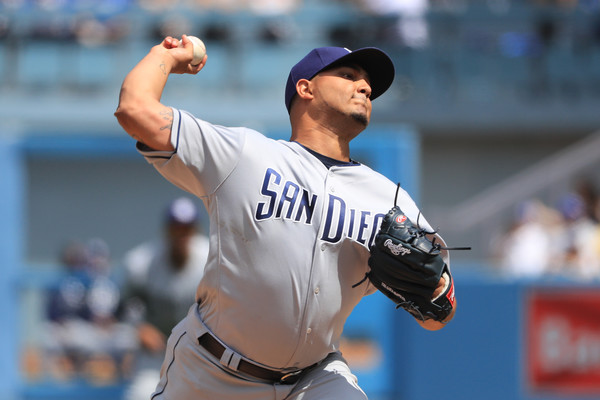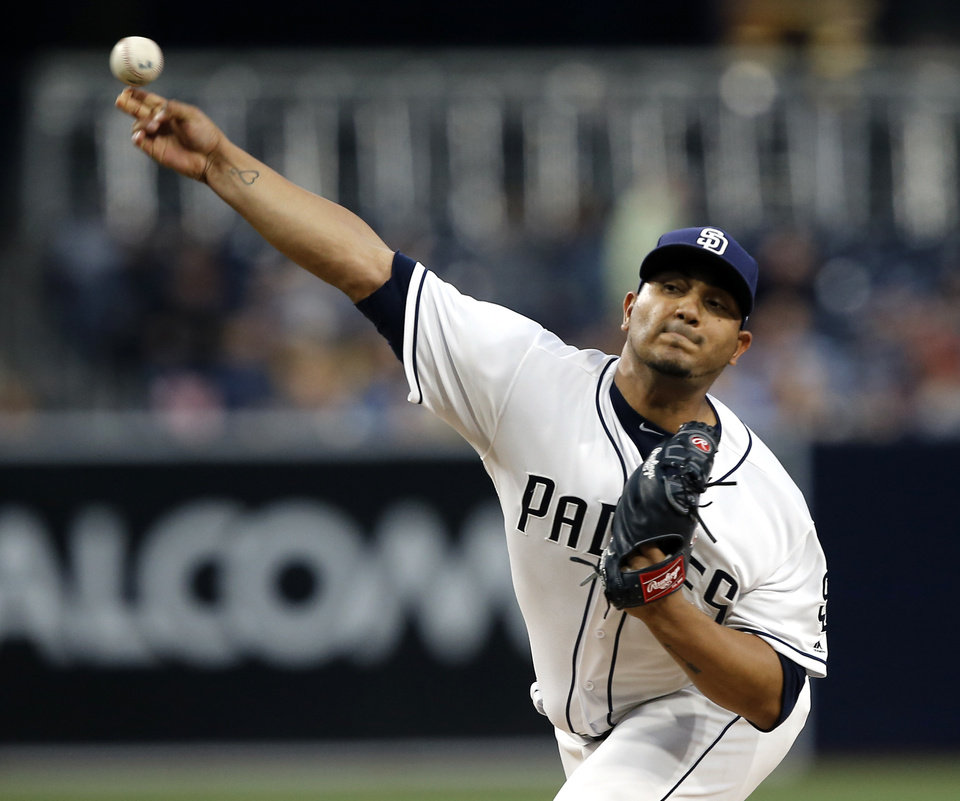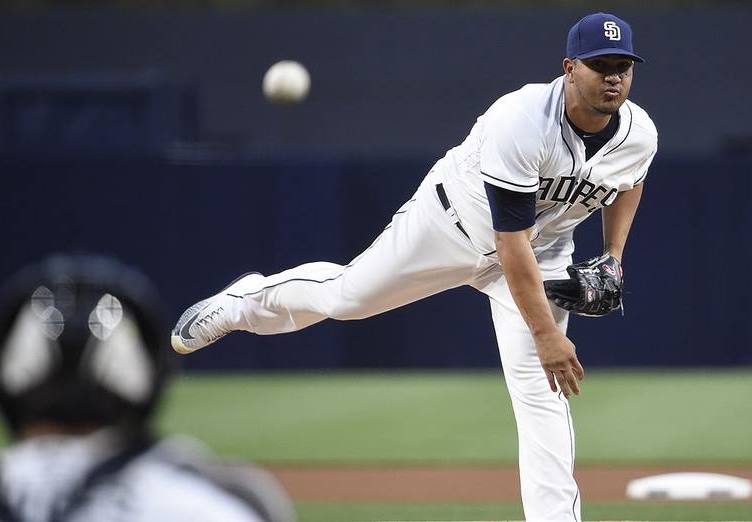Possible Scenarios for the San Diego Padres & Jhoulys Chacin


With few reliable and durable rotation options following the conclusion of the 2016 season, A.J. Preller had to go search in the bargain bin to find some pitchers to fill out his starting five. He settled upon Clayton Richard, Jered Weaver, Trevor Cahill, and the subject of this article, Jhoulys Chacin, all for $3 million or less.
As for the first three; Richard re-upped with the Friars for two years in September, Weaver retired in August after attempting to come back from injury, and Cahill had a successful first half with San Diego before being swapped to the Royals at the deadline and imploding.
Now, that accounts for all three except Chacin, who easily had the best season of the four.
Over 180.1 innings pitched, he allowed 78 earned runs, which amounts to a 3.89 earned run average(ERA), as well as 153 strikeouts and 72 walks, while only surrendering 19 home runs. That 3.89 ERA doesn’t jump off the page because it shouldn’t, but that number also doesn’t have any context.
Once you dig a little deeper, you will find that Chacin was one of the best pitchers at home in the entire league, leading all qualified starters in home ERA at a sterling 1.79 mark, slightly ahead of uber ace Corey Kluber, and significantly ahead of third place southpaw Dallas Keuchel.
While it would be easy to dismiss this feat as being a part of the Petco Park effect, it should also be considered that it’s also the third-lowest home ERA for a Padre since they moved into Petco. So obviously, Jhoulys loves to pitch at Petco, maybe a little more than the average pitcher.
But now, with the World Series going on and the offseason fast approaching, Jhoulys Chacin‘s contract is set to expire and he will hit the open market, free to sign with any other team. Now, Preller must decide on whether he should keep Chacin around with a contract extension, extend him a qualifying offer (worth approximately $18.1 million) and possibly reap draft pick compensation should he sign elsewhere, or let him go for nothing but also not at the risk of him accepting the qualifying offer.
Sign Him to a Contract
The first option to consider should be to re-sign Chacin, as he was obviously a valuable asset to the team in the 2017 season, tying for the club lead among pitchers with 2.3 wins above replacement(WAR). For a team that still doesn’t have a rotation set in stone, to be able to firmly pencil Chacin in with Clayton Richard would add stability to a club that really needs it.
As of now, there could be potentially eight candidates to fill those last three spots, and none of them have more than two full seasons in an MLB rotation. Chacin, while not an ace, could take up valuable innings while some younger pitchers get much-needed development time in the minors, instead of being rushed to the majors. But to make it happen, Chacin would need to be paid, and paid pretty well too considering his resurgent year and the dearth of quality starting pitchers on the free agency market. If Chacin played his cards right and created a bidding war between teams in dire need of starters after the more quality pitchers are signed, he could command a three, possibly four-year deal. That is a best-case scenario for him, but re-signing Jhoulys won’t come as cheap as it was the last offseason.

However, the Padres are the perfect team to fit a slightly larger contract on their budget because of their lack of long-term commitments to players; Wil Myers is the only player on the team with a guaranteed contract longer than two years. Now, this doesn’t mean Preller should pull out all the stops to sign Chacin; he’s no ace, and it can be easy to forget that he barely got a major league contract last offseason, and even his 2017 wasn’t without its negatives, as he was atrocious on the road, compiling a 6.53 ERA in 80 innings pitched while away from San Diego. In the end, however, Preller should make a concerted effort to bring back Chacin, considering how comfortable he is at Petco Park, and that he can soak up innings while providing a veteran presence for young studs like Dinelson Lamet, Luis Perdomo, and Miguel Diaz.
Qualifying Offer
The second option would be to extend a qualifying offer to Jhoulys Chacin, which is a one-year, $18.1 million dollar contract, that if rejected, allows the Padres to collect draft pick compensation should Chacin sign elsewhere in the offseason. Many teams will offer this to their top free agents to make sure their top talent doesn’t leave and they get nothing in return. As the qualifying offer system has gotten older, the threshold of talent for offering these qualifying offers seems to have gone down, but that has also lead to an increase in the number of offers accepted.
Jeremy Hellickson, Colby Rasmus, and Brett Anderson are three examples of players who accepted these one-year deals, despite not one of them ever making a MLB All-Star game appearance. Jhoulys Chacin’s closest comparable among those three is Hellickson. Both showed early career promise (Hellickson would win Rookie of the Year in 2011, while Chacin managed to put up a 3.78 ERA in six years with the Rockies, a very impressive feat), before losing some of their luster, eventually seeming to figure it all out again with one team a couple of seasons later. When Hellickson was offered the qualifying offer, many wondered what the Phillies were thinking. He had been in the trash heap for the Diamondbacks just a season earlier, so many wondered if one good season was enough to warrant a one-year contract with a very high salary. Hellickson decided to accept the offer and his 2017 season proved not to be worth the high price tag, as he would go on to have a subpar first half with the Phillies before a deadline swap with the Orioles, where he performed even worse.
This shows that nothing is certain in baseball, and that just because a team may have the budget to sign a player for a lot of money doesn’t mean they should. A player could just as easily regress as he can build off his progress. Jhoulys Chacin, while a very valuable player for the Padres last year, won’t be worth the $18.1 million price tag that would come with the qualifying offer. This is not really an option the more you think about it.
Free Agency
The third option is to simply let Jhoulys Chacin walk in free agency with no qualifying offer attached to him, but without the risk of him accepting. This route would hold the least potential reward but also holds no risk. The Padres could just use the money they potentially would have used to keep Chacin on another pitcher to eat up innings, albeit at a much cheaper rate hopefully. Someone like Tyler Chatwood, Jaime Garcia, or Jason Vargas would all be good fits to take up innings in the Padres rotation if they can be had inexpensively.
Meanwhile, Chacin would be able to sign with any other team without the shackles of draft pick compensation attached to him. This is assuming he would reject the QO, which is a very unlikely scenario to start with. In the end, this may end up being the path Preller takes with Chacin, as he is unlikely to replicate his amazing success at home once again in 2018. Preller may want to see what his young guns can do over a full MLB season and give them experience, before he plans to take the team down a contending path potentially as soon as 2019.
Kent is high school student, and is the youngest writer at East Village Times. He plays baseball, and runs cross country. He is also a Life Scout currently working towards the rank of Eagle. He was born in San Diego, and been a Padres fan ever since.
how insightful and neat. a great article 11/10